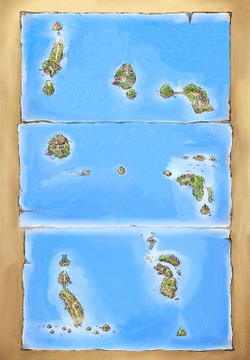Sevii Islands: Difference between revisions
Pale Prism (talk | contribs) m (→Geography) |
Pale Prism (talk | contribs) (Consistency) |
||
| Line 22: | Line 22: | ||
The main islands' only game appearance was in {{game|FireRed and LeafGreen|s}}, but the two event-exclusive islands, [[Navel Rock]] and [[Birth Island]], later reappeared in {{game|Emerald}}. The Sevii Islands also appear in other media based on these games. | The main islands' only game appearance was in {{game|FireRed and LeafGreen|s}}, but the two event-exclusive islands, [[Navel Rock]] and [[Birth Island]], later reappeared in {{game|Emerald}}. The Sevii Islands also appear in other media based on these games. | ||
== | ==Geography== | ||
===Demographics=== | ===Demographics=== | ||
The population of Sevii Islands is 220, including all towns and other areas. | The population of Sevii Islands is 220, including all towns and other areas. | ||
===Settlements=== | ===Notable locations=== | ||
The nine Sevii Islands are a part of the Kanto region, located to the south of mainland Kanto. These islands cannot be surfed to; to travel from island to island a Pokémon Trainer must take the [[Seagallop]] Ferries from another island or [[Vermilion City]] in [[Kanto]]. | |||
====Settlements==== | |||
The seven major islands each have a settlement, which are named numerically. | The seven major islands each have a settlement, which are named numerically. | ||
| Line 58: | Line 59: | ||
|} | |} | ||
===Landmarks=== | ====Landmarks==== | ||
*[[One Island]] | *[[One Island]] | ||
**[[Treasure Beach]] | **[[Treasure Beach]] | ||
| Line 97: | Line 98: | ||
*[[Birth Island]] | *[[Birth Island]] | ||
==Appearance | ===Appearance=== | ||
{| style="margin:auto; text-align:center; {{roundy|20px}} border:2px solid #{{sevii color dark}}; background:#{{sevii color}}; font-size:80%" | {| style="margin:auto; text-align:center; {{roundy|20px}} border:2px solid #{{sevii color dark}}; background:#{{sevii color}}; font-size:80%" | ||
|- | |- | ||
Revision as of 01:07, 29 August 2021
| |||||||||||||||||||
| |||||||||||||||||||
| |||||||||||||||||||
| |||||||||||||||||||
| |||||||||||||||||||
| |||||||||||||||||||
The Sevii Islands (Japanese: ナナシマ Nanashima) are an archipelago in the Kanto region consisting of nine large islands and several small islands surrounding them. They are located far south of the Kanto mainland, and are home to several Legendary and Mythical Pokémon: Moltres, Lugia, Ho-Oh, and Deoxys.
The main islands' only game appearance was in Pokémon FireRed and LeafGreen, but the two event-exclusive islands, Navel Rock and Birth Island, later reappeared in Pokémon Emerald. The Sevii Islands also appear in other media based on these games.
Geography
Demographics
The population of Sevii Islands is 220, including all towns and other areas.
Notable locations
The nine Sevii Islands are a part of the Kanto region, located to the south of mainland Kanto. These islands cannot be surfed to; to travel from island to island a Pokémon Trainer must take the Seagallop Ferries from another island or Vermilion City in Kanto.
Settlements
The seven major islands each have a settlement, which are named numerically.
| Map | Name |
|---|---|
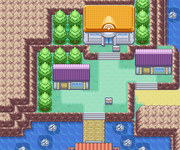
|
One Island |

|
Two Island |
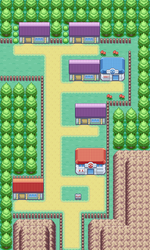
|
Three Island |
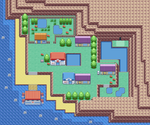
|
Four Island |
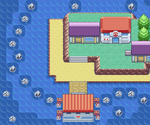
|
Five Island |
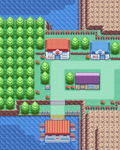
|
Six Island |
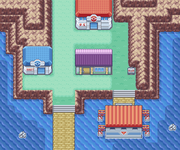
|
Seven Island |
Landmarks
- One Island
- Two Island
- Three Island
- Four Island
- Five Island
- Six Island
- Seven Island
- Navel Rock
- Birth Island
Appearance
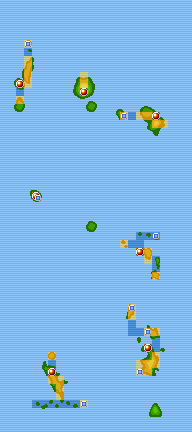
|
| The Sevii Islands as seen in Pokémon FireRed and LeafGreen |
In the games
Plot
The Sevii Islands follow a trend set by Pokémon Gold and Silver, and provide most of the post-Pokémon League plot in Pokémon FireRed and LeafGreen. The Sevii Islands sideplot actually begins as soon as the player has defeated the Cinnabar Gym and obtained the Volcano Badge. The first three islands, One, Two, and Three, are the only ones that are initially accessible, but the plot here is important for continuing the game. By obtaining the National Pokédex (and subsequently retrieving the Ruby), the later islands are unlocked.
There is also a plot by Team Rocket based in the Sevii Islands. It deals with Pokémon evolution, and appears to be the prelude to a plot that is launched three years later. Only when the Team Rocket members realize that the player has already defeated Giovanni, who subsequently disbanded Team Rocket, do they give up.
Some of the Sevii Islands' background music tracks are remixed themes from Gold and Silver, specifically the ones from Violet City/Olivine City (Six Island and Seven Island), Azalea Town/Blackthorn City (Four Island and Five Island), and Routes 42, 43, 44, and the Lake of Rage (routes on Five, Six, and Seven Islands).
Accessibility
In FireRed and LeafGreen, the Sevii Islands are accessible from the Vermilion City harbor via a system of boats called the Seagallop Ferries. To be able to access One, Two, and Three Islands, one needs a Tri-Pass, received from Celio after defeating Blaine on Cinnabar Island. To be able to access Four, Five, Six, and Seven Islands, one needs a Rainbow Pass, received from Celio in One Island, after entering the Hall of Fame and obtaining the National Pokédex. To be able to access Navel Rock, one needs a MysticTicket, and to be able to access Birth Island, one needs an AuroraTicket, both of which can be obtained promotionally with Mystery Gift.
In the anime

The Sevii Islands have only been featured in The Search for the Legend, where Ritchie visited Mt. Ember (referred to as Mt. Magma in the dub) on One Island. The episode focused on the Moltres living on the mountain.
The Sevii Islands also appear in the anime map released with The Rise of Darkrai. According to the map, the Sevii Islands are in relatively the same area as the Orange Islands and New Island.
In the manga
Pokémon Adventures
FireRed & LeafGreen arc
The Sevii Islands were the main setting for this chapter. It focused on the three original Kanto Pokédex holders dealing with Deoxys, based on the Birth Island event, as well as the resurgence of Team Rocket.
Trivia
- Data in the games reserved for location name index pointers reveal the following values:
- Sevii Isle 6 (Japanese: 6ばんななしま Nanashima 6)
- Sevii Isle 7 (Japanese: 7ばんななしま Nanashima 7)
- Sevii Isle 8 (Japanese: 8ばんななしま Nanashima 8)
- Sevii Isle 9 (Japanese: 9ばんななしま Nanashima 9)
- Sevii Isle 22 (Japanese: 22ばんななしま Nanashima 22)
- Sevii Isle 23 (Japanese: 23ばんななしま Nanashima 23)
- Sevii Isle 24 (Japanese: 24ばんななしま Nanashima 24)
- These routes are not accessible during normal gameplay and are likely remnants from the development period of the games.
- The routes on the Sevii Islands are not numbered, unlike the other regions. This is likely to prevent confusion as to their relation to the others, as continuing where Johto left off (after Route 46, at the time the highest-numbered Johto route) would seemingly imply that Johto is accessible in the games.
Origin
The Sevii Islands archipelago corresponds to the real-life Izu Islands and Bonin Islands. One through Five Island as well as Navel Rock are based on the Izu Islands, while Six and Seven Island correspond to Chichijima and Hahajima in the Bonin, and Birth Island corresponds to Minami-Tori-shima (an island grouped administratively with the Bonin Islands, but not considered to be a part of them geographically).
Name origin
The name possibly combines the number seven and the Roman numeral for seven, VII. The Japanese name Nanashima literally means "seven islands". According to an old woman on Seven Island, they were named the Sevii Islands not because there are seven (two event items reveal there are in fact nine), but because they were supposedly made in seven days.
In other languages
| Language | Name | Origin |
|---|---|---|
| French | Îles Sevii | Same as English name |
| German | Sevii Eiland | Same as English name |
| Italian | Settipelago | From sette (seven) and archipelago |
| Spanish | Archi7 Islas Sete |
From archipelago and 7 Corruption of siete (seven) |
| Korean | 일곱섬 Ilgop Seom | Translation of Japanese name |
| Chinese (Mandarin) | 七之島 / 七之岛 Qī-zhī Dǎo* 七岛 Qīdǎo* |
Translation of Japanese name |
| Chinese (Cantonese) | 七之島 Chāt-jī Dóu | Same as Taiwanese name |
| Brazilian Portuguese | Ilhas Sevii | Same as English name |
| Vietnamese | Thất Đảo | From thất (seven) and đảo (island) |
| Regions in the Pokémon world | ||
|---|---|---|
| Sevii Islands | |||||||||
|---|---|---|---|---|---|---|---|---|---|
|
| |||||||||
| |||||||||

|
This article is part of Project Locations, a Bulbapedia project that aims to write comprehensive articles on every location in the Pokémon world. |
